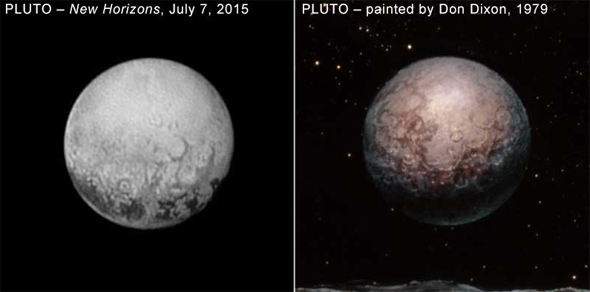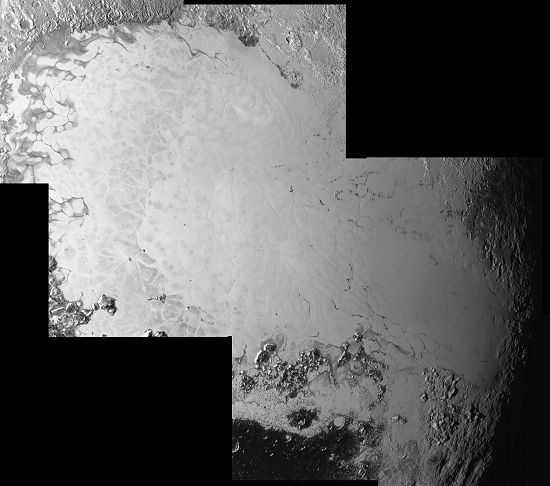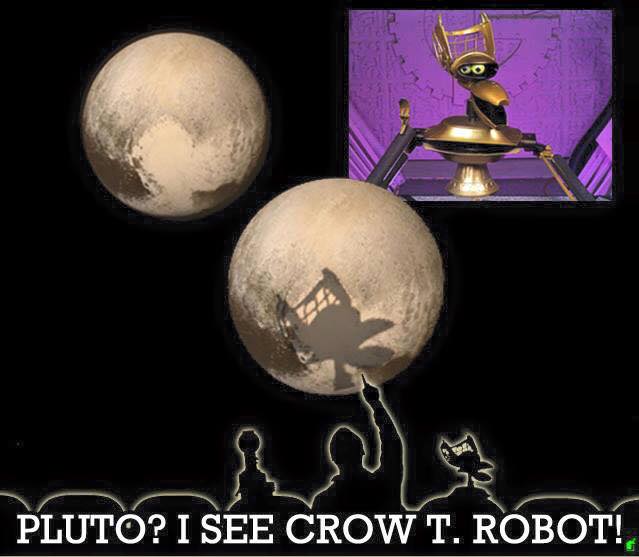It looks like you're using an Ad Blocker.
Please white-list or disable AboveTopSecret.com in your ad-blocking tool.
Thank you.
Some features of ATS will be disabled while you continue to use an ad-blocker.
share:
Thats a planet. Pluto will always have a place in my solar system.
Thanks for sharing.
Thanks for sharing.
originally posted by: Blue Shift
Now would be a good time for anybody with previous "predictions" about specific features on Pluto -- given to them by aliens or remote viewing or whatever -- to come forward and be vindicated.
You'll be interested in this, then: Life Imitates Art: Pluto’s Face Predicted in 1979

That’s the cover space artist Don Dixon did for the book Out of Darkness: The Planet Pluto, by Clyde Tombaugh and Sir Patrick Moore in 1979.
And this is more than coincidence! As he writes on his Cosmographica site, the overall look of Pluto is probably modified by ices on its surface sublimating (turning directly into gas) during local summer and redepositing elsewhere on the surface where it’s colder. That means craters and lowlands should have different brightnesses … just as we’ve now seen with New Horizons.
And the color he used may be pretty close, but that’s not coincidence either; we’ve known for some time that methane on the surface would get hit by ultraviolet light from the Sun and turn into more complex organic compounds called tholins, which are reddish. The colors we’re actually seeing so far are more orangey than red, but close enough.
The Pluto on Pluto thing is a windfall for Disney, and the most publicity Pluto (either or) has had in decades (except for the diminished planet
setback and the Minnie scandal).
After seeing the size comparison with the Earth and moon, I would say it should be classed as a dwarf planet. It's even smaller than I thought.
a reply to: Chadwickus
a reply to: Chadwickus
Can Pluto and Neptune ever collide?
Not in the present epoch. They share a 2:3 orbital resonance (Pluto completes two solar orbits for every three of Neptune), so they can't come anywhere near each other. In fact, Pluto can come closer to Uranus than it can ever come to Neptune! Having said that, it's always possible that this orbital resonance will be broken in the far future. Orbits are ultimately chaotic when you have hundreds of thousands of objects in the same system, where each of them exerts a small gravitational tug. Most of these may not be significant over short timescales, but they can eventually add up. Nevertheless, you have to bear in mind that this gravitational dance has survived for 4.5 billion years, so that's a strong indication that it is pretty stable!
edit on 17-7-2015 by Mogget because: (no reason given)
originally posted by: wildespace
originally posted by: Blue Shift
Now would be a good time for anybody with previous "predictions" about specific features on Pluto -- given to them by aliens or remote viewing or whatever -- to come forward and be vindicated.
You'll be interested in this, then: Life Imitates Art: Pluto’s Face Predicted in 1979
That’s the cover space artist Don Dixon did for the book Out of Darkness: The Planet Pluto, by Clyde Tombaugh and Sir Patrick Moore in 1979.
And this is more than coincidence! As he writes on his Cosmographica site, the overall look of Pluto is probably modified by ices on its surface sublimating (turning directly into gas) during local summer and redepositing elsewhere on the surface where it’s colder. That means craters and lowlands should have different brightnesses … just as we’ve now seen with New Horizons.
And the color he used may be pretty close, but that’s not coincidence either; we’ve known for some time that methane on the surface would get hit by ultraviolet light from the Sun and turn into more complex organic compounds called tholins, which are reddish. The colors we’re actually seeing so far are more orangey than red, but close enough.
There is even a heart on his Pluto painting. Either he has seen Pluto or he has some mystical way and connection to it. No way you get that close and not be in the know somehow.
Sure looks like a planet to me. "Dwarf planet" "planet" whatever. A planet is a planet. This is why the whole pluto change was dumb. It was done based
on the concept that they think only gas giants can exist at those distances with no solid data to support that theory, so Pluto must not be a planet.
Well, I'm looking at it. Pretty obviously a planet to my eyes complete with moons, and not some rock floating out in space as they expected. I can't
believe Pluto has to share the title "dwarf planet" with Ceres which is basically a moon without a planet...
Some people are feeling pretty dumb about now but I will expect them to stick to their guns publicly that they made the right call for Pluto. All I can say is, put those Pluto FACTs in your pipe and smoke it, Neil deGrasse "Pluto had it coming, get over it!" Tyson. No one thinks about disqualifying Earth as a planet or giving it a new title just because the gas giants dwarfs it. The next logical step is to either redefine Pluto as a planet or redefine the inner planets to separate them from the gas giants. Can't have your cake and eat it, too.
Some people are feeling pretty dumb about now but I will expect them to stick to their guns publicly that they made the right call for Pluto. All I can say is, put those Pluto FACTs in your pipe and smoke it, Neil deGrasse "Pluto had it coming, get over it!" Tyson. No one thinks about disqualifying Earth as a planet or giving it a new title just because the gas giants dwarfs it. The next logical step is to either redefine Pluto as a planet or redefine the inner planets to separate them from the gas giants. Can't have your cake and eat it, too.
a reply to: Xeven
From Don Dixon himself:
Source
From Don Dixon himself:
I'd like to claim prophetic powers, but the painting was guided by the reasonable assumption that Pluto likely has a periodically active atmosphere that distributes powdery exotic frosts into lowland areas. The reddish color of the higher features is caused by tholins – hydrocarbons common in the outer solar system. The partial circular arcs would be caused by flooding of craters by slushy exotic ices. Pluto is apparently more orange than I painted it, however; I assumed the exotic ices would push colors more into the whites and grays.
Source
originally posted by: smurfy
I'll tell you what...Pluto's a planet! Look how round it is, in that picture anyway.
While I also am hurt that our excellent mothers only send us nine now and we no longer get pizza, the primary criterion for which Pluto was demoted was that it has not cleared its orbit of space debris. As such, it is considered a Kuiper Belt Object and a Dwarf Planet until the criterion changes again.
a reply to: Xeven
When reading about his painting and his understanding of the forces involved in planetary make-ups, I tend to think that not only did he understand what Pluto should look like, but in a way, through his understanding, he remote viewed it without realizing it.
But that is just what I think.
When reading about his painting and his understanding of the forces involved in planetary make-ups, I tend to think that not only did he understand what Pluto should look like, but in a way, through his understanding, he remote viewed it without realizing it.
But that is just what I think.
originally posted by: Jekka
originally posted by: smurfy
I'll tell you what...Pluto's a planet! Look how round it is, in that picture anyway.
While I also am hurt that our excellent mothers only send us nine now and we no longer get pizza, the primary criterion for which Pluto was demoted was that it has not cleared its orbit of space debris. As such, it is considered a Kuiper Belt Object and a Dwarf Planet until the criterion changes again.
Yeah but to be fair neither Earth nor Jupiter has cleared its orbit either, so. . .
originally posted by: jaffo
originally posted by: Jekka
originally posted by: smurfy
I'll tell you what...Pluto's a planet! Look how round it is, in that picture anyway.
While I also am hurt that our excellent mothers only send us nine now and we no longer get pizza, the primary criterion for which Pluto was demoted was that it has not cleared its orbit of space debris. As such, it is considered a Kuiper Belt Object and a Dwarf Planet until the criterion changes again.
Yeah but to be fair neither Earth nor Jupiter has cleared its orbit either, so. . .
Yeah there are the objects that share orbits with Earth, Jupiter and a few others but they are relatively small. When the requirement is applied to Pluto or Ceres, you then look at the fact that Ceres is in the asteroid belt and Pluto is in the Kuiper belt. I guess to them a few objects is one thing but an entire belt of objects is another. Good point nonetheless.
originally posted by: jaffo
Yeah but to be fair neither Earth nor Jupiter has cleared its orbit either, so. . .
They cleared it of similarly-sized objects, and are gravitationally dominant in their orbits. That's the actual detailing of the "cleared its neighbourhood" factor. Pluto isn't gravitationally dominant in its orbit; it crosses the orbit of Nepute and got locked into an orbital resonance with it.
Jupiter's "trojan" asteroids are only there because Jupiter's gravity keeps them there.
When a planet forms (and grows) from the primordial material, smaller bodies either impact it, get flung away, or get locked into some stable (but subordinate) orbit in the vicinity. The planet then has a relatively clear and dominant orbit around its star. Such is the case with Jupiter, Neptune, etc. but not with Pluto.
Pluto posts have petered out for some reason, so have a stunning and very detailed mosaic from the latest images, made by a member on the UMSF forum:
mc.herobrinesarmy.com...

I made one myself too, using Microsoft ICE software, and rotated the image so that north is roughly up: www.flickr.com...
The icy plains (Sputnik Planum) look very beautiful in closeups: pluto.jhuapl.edu...

I made one myself too, using Microsoft ICE software, and rotated the image so that north is roughly up: www.flickr.com...
The icy plains (Sputnik Planum) look very beautiful in closeups: pluto.jhuapl.edu...
edit on 25-7-2015 by wildespace
because: (no reason given)
originally posted by: Darkblade71
a reply to: Xeven
When reading about his painting and his understanding of the forces involved in planetary make-ups, I tend to think that not only did he understand what Pluto should look like, but in a way, through his understanding, he remote viewed it without realizing it.
But that is just what I think.
Hmmm....Possibly, but it seems to me like it's far more likely that this artist, as an educated professional, was able to make rather accurate inferences based on the known data that he had to work with...
new topics
-
Paramilitary Leaks - John Williams
Whistle Blowers and Leaked Documents: 1 hours ago -
Some sausage, some chicken, some sauce, some onions and some garlic...and some peppers!
Food and Cooking: 2 hours ago -
Hearing more ambulances lately
Medical Issues & Conspiracies: 3 hours ago -
Los Angeles brush fires latest: 2 blazes threaten structures, prompt evacuations
Mainstream News: 3 hours ago -
House Passes Laken Riley Act
Mainstream News: 4 hours ago -
The more I think about it
General Chit Chat: 4 hours ago -
What Comes After January 20th
Mainstream News: 6 hours ago -
Canada as a state .. how would it work?
General Chit Chat: 6 hours ago -
Those stupid GRAVITE commercials
Rant: 7 hours ago -
Let's Buy Greenland
General Chit Chat: 8 hours ago
top topics
-
House Passes Laken Riley Act
Mainstream News: 4 hours ago, 21 flags -
What Comes After January 20th
Mainstream News: 6 hours ago, 18 flags -
Claim: General Mark Milley Approved Heat and Sound Directed Energy Weapons During 2020 Riots
Whistle Blowers and Leaked Documents: 12 hours ago, 12 flags -
Planned Civil War In Britain May Be Triggered Soon
Social Issues and Civil Unrest: 11 hours ago, 6 flags -
Let's Buy Greenland
General Chit Chat: 8 hours ago, 5 flags -
Those stupid GRAVITE commercials
Rant: 7 hours ago, 5 flags -
Hearing more ambulances lately
Medical Issues & Conspiracies: 3 hours ago, 4 flags -
Los Angeles brush fires latest: 2 blazes threaten structures, prompt evacuations
Mainstream News: 3 hours ago, 4 flags -
The more I think about it
General Chit Chat: 4 hours ago, 4 flags -
Canada as a state .. how would it work?
General Chit Chat: 6 hours ago, 3 flags
active topics
-
-@TH3WH17ERABB17- -Q- ---TIME TO SHOW THE WORLD--- -Part- --44--
Dissecting Disinformation • 3963 • : fringeofthefringe -
Judge rules president-elect Donald Trump must be sentenced in 'hush money' trial
US Political Madness • 51 • : JadedGhost -
House Passes Laken Riley Act
Mainstream News • 12 • : xuenchen -
This is why ALL illegals who live in the US must go
Social Issues and Civil Unrest • 38 • : fringeofthefringe -
Paramilitary Leaks - John Williams
Whistle Blowers and Leaked Documents • 4 • : xuenchen -
What Comes After January 20th
Mainstream News • 22 • : WeMustCare -
Those stupid GRAVITE commercials
Rant • 10 • : nugget1 -
Canada as a state .. how would it work?
General Chit Chat • 14 • : boatguy12 -
Los Angeles brush fires latest: 2 blazes threaten structures, prompt evacuations
Mainstream News • 8 • : Vermilion -
GOD may be ANGRY at CALIFORNIA for Becoming an ABORTION Mecca.
Conspiracies in Religions • 200 • : WeMustCare

